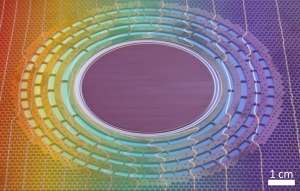Researcher construct invisibility cloak for thermal flow

By means of special metamaterials, light and sound can be passed around objects. KIT researchers now succeeded in demonstrating that the same materials can also be used to specifically influence the propagation of heat. A structured plate of copper and silicon conducts heat around a central area without the edge being affected. The results are presented in the Physical Review Letters journal.
"For the thermal invisibility cloak, both materials have to be arranged smartly," explains Robert Schittny from KIT, the first author of the study. Copper is a good heat conductor, while the silicon material used, called PDMS, is a bad conductor. "By providing a thin copper plate with annular silicon structures, we produce a material that conducts heat in various directions at variable speeds. In this way, the time needed for passing around a hidden object can be compensated."
If a simple, solid metal plate is heated at the left edge, heat migrates uniformly to the right side. The temperature of the plate decreases from the left to the right. Exactly the same behavior is exhibited by the new metamaterial consisting of copper and silicon outside of the annular structure. No heat penetrates inside. Outside, there is no indication of what happens inside.
"These results impressingly reveal that transformation optics methods can be transferred to the highly different area of thermodynamics," says Martin Wegener, Head of the Institute of Applied Physics of KIT. Here, the first three-dimensional invisibility cloak for visible light was developed. While optics and acoustics are based on the propagation of waves, heat is a measure of the unordered movement of atoms. Still, basic mathematical descriptions can be used to calculate the structures having the effect of an invisibility cloak. With the methods of so-called transformation optics, a distortion of the describing coordinate system is calculated. Arithmetically speaking, an extended object disappears in an infinitely small point. This virtual distortion can be mapped to a real metamaterial structure that passes incident light around the object to be hidden, as if it was not even existing.
"I hope that our work will be the basis of many further developments in the field of thermodynamic metamaterials," Wegener says. Thermal invisibility cloaks are a rather new field in fundamental research. In the long term, they might be applied in areas needing effective heat management, such as in microchips, electric components, or machines.
More information: Experiments on Transformation Thermodynamics: Molding the Flow of Heat, R. Schittny, M. Kadic, S. Guenneau, and M. Wegener, PRL, 2013.
Journal information: Physical Review Letters
Provided by Helmholtz Association of German Research Centres


















